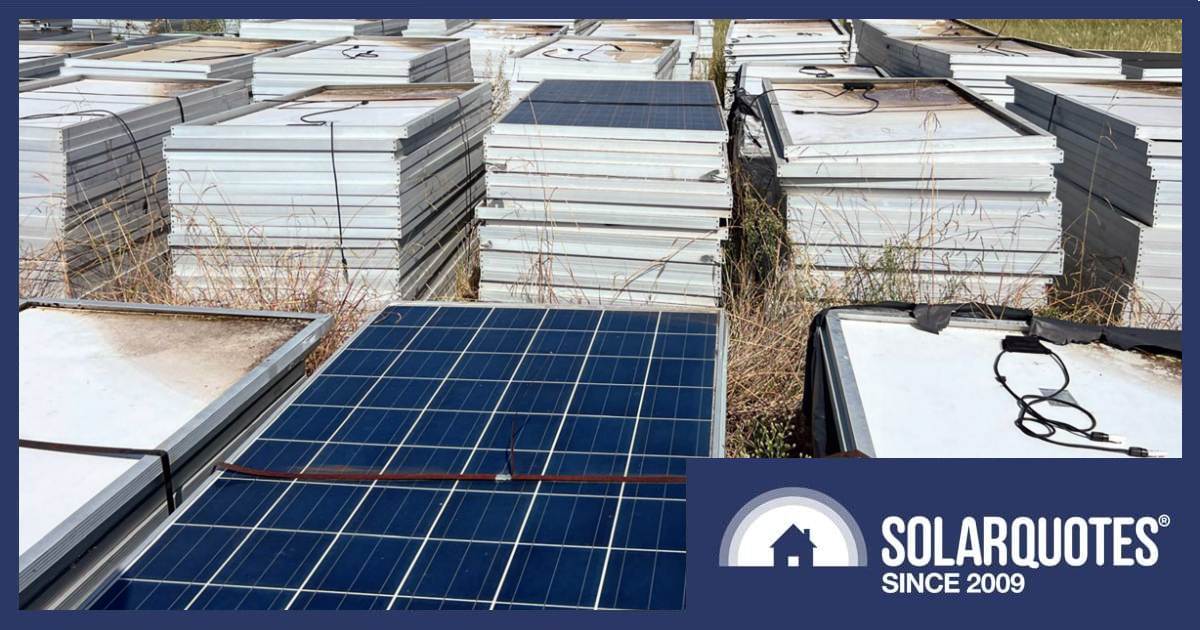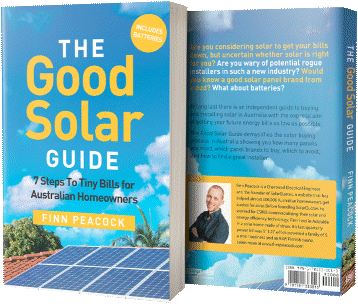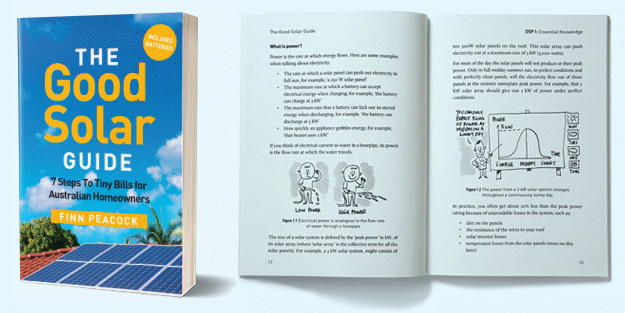
Only a small percentage of Australia’s decommissioned solar panels are being recycled. This isn’t through a lack of know-how, but a failure to act by successive governments according to a joint statement signed by dozens of groups.
Call For Government Action On Solar PV Waste
Led by the Smart Energy Council, a coalition of dozens of industry, business, union, community and environmental groups and local governments is calling on the Federal Government to establish a mandatory product stewardship scheme for solar panels during this parliamentary term. The Federal Government is also being urged to implement a funded pilot program in the interim that would inform scheme design and attract investment to ensure its success.
The joint statement claims it’s a $6.5 billion opportunity that could boost critical mineral resource security, spark innovation, new local industries, manufacturing and jobs.
Progress (Or Lack Thereof) To Date
Australia’s solar revolution has been nothing short of stunning. Millions of solar panels adorn rooftops throughout the country, not to mention the millions more installed at solar farms.
Good quality solar panels should last for decades, and they’ve been proven to in real-world conditions. Unfortunately not all solar panels are of good quality, and the service lives of many panels are being ended prematurely through system upgrades.
In 2021, then-Federal Minister for the Environment, Sussan Ley, put the solar industry on notice that an industry-led nationwide stewardship scheme design must be finalised by June 2022. At the time, the Clean Energy Council (CEC)1 pushed back, stating it had worked to develop a comprehensive, nationwide plan over the previous twelve months, but the Federal Government had “walked away” from the partnership.
In the years since, there have been various proposals and opinions expressed by government departments. For example, this year the Productivity Commission signalled its support for establishing a co-regulatory product stewardship scheme for solar PV.
But still, no scheme.
“Time is up, and Australia’s renewable energy sector stands ready to act,” says the statement. “This is a resource solution, rather than a waste problem.”
What Materials Can Be Reclaimed From Solar Panels?
Just about everything:
- Glass
- Aluminium
- Silicon
- Copper
- Silver
- Junction/terminal box materials
- Cables
- Even the ethylene-vinyl acetate (EVA) encapsulant.
The aluminium frame and glass alone represent a major proportion of a solar panel’s weight — around 85%. But recovery of all materials that can be reclaimed is still costly and energy-intensive; so it’s mainly the glass and aluminium that get attention.
A Waste ‘Crisis’
While technology capable of 95%+ material recovery exists in Australia and several recycling/reclamation facilities have been established, another issue is logistics. The cost of transporting panels to a recycling facility can be greater than that of sending them to a local landfill. And even that undesirable outcome is no longer an option in some jurisdictions due to e-waste crackdowns.
To this point, the bulk of decommissioned modules have headed overseas for reuse in other countries, but current super-low prices for new solar panels is seeing that demand impacted.
According to the Smart Energy Council, installers and households are being forced into stockpiling panels, and illegal dumping incidents in regional and rural areas are increasing.
“There is an escalating solar PV panel waste crisis looming, with serious environmental and social impacts set to follow,” says the statement. “Panel decommissionings are set to double, and a recycling industry that has invested heavily on the promise of a national product stewardship scheme will stagnate and decline, with associated job losses, after a decade of policy inaction.”
Back in 2019, SolarQuotes’ resident fact-checker Ronald Brakels said there was no waste crisis on the horizon. Still, our habit of sweeping crap under the rug (landfill) isn’t the best way to deal with most forms of waste; and illegal dumping is abhorrent — not just in terms of environmental and aesthetic issues, but the clean-up cost.
So, the focus should be making solar panel recycling/materials reclamation as efficient and cost-effective as possible. And on that note, how does a container deposit- type scheme sound?
Footnotes
- Interestingly, the CEC’s logo is nowhere to be seen among the dozens on the joint statement. ↩

 RSS - Posts
RSS - Posts



Totally agree Local government transfer stations should be the conduit for solar recycling schemes and if it costs a small amount to make sure your panels get recycled I’m sure many would be happy to pay
We are good at recycling it shouldn’t be so hard to achieve!
There was actually a guy in my area asking what to do with old, maybe non-functional, panels that had been lying around his place for eons. Much of the advice was basically contact Labor if waste facilities don’t deal with it.
Given how rare it is still for folk to have old solar panels to dump, wouldn’t it be a headache for most waste facilities to deal with? They’d simply sit around for months before enough was collected to make it worthwhile for anyone to collect it.
On the website for local services it states that overseas markets for general recycling have basically closed, raising the cost for it, and there are very few viable options in Australia. If basic recycling is a problem, then how much more for specialist solar recycling?
So, what is the issue with solar panels in land fill? do they degrade into something toxic or something that normal landfill linings can’t contain?
I mean we are a country that makes large numbers of honking great big holes to export raw materials etc to make our money, so we are not short of old holes to put stuff in that doesnt cause issues.
The problem is that no one wants a landfill site in their backyard. I can still remember car bodies being buried in our local tip. Then legislation made that illegal. Then a legislation change made recycled concrete able to be used as a road base. These 2 changes extended the life of our local tip by more than 10 years. I don’t think burying glass and aluminium back in the ground makes any sense when we have put so much effort into digging it up and smelting it in the first place?
The big holes we dig are often nowhere near where we live and so in my area we tend to fill up our creek valleys and low lying land with our discarded crap instead. Then we complain when we contaminate our waterways with toxic leaching.
Anyone wanting to stump up the startup cost? Until then it remains “Somebody Else’s Problem.”
If the government can’t lead on this then we should. I would happily pay an appropriate levy to show we are serious about decarbonising while keeping environmental damage to an absolute minimum otherwise we are tackling on crisis while exacerbating another. Governments should not be giving incentives for green energy take-up without providing support for recycling.
Most decommissioned panels still have a long potential life ahead of them.
There is still too much talk of crushing and recycling of perfectly good panels.
Any that are assessed as being good enough quality and haveing life left in them, should be diverted to low cost redeployment (much like Redwood Materials are doing to used Lithium Batteries in Navada, before they recycle them). If they can’t be cost effectively redeployed, then they should be put into longterm storage in the desert. I would call it a ‘National Strategic Reserve’ (like the US has for oil) but for our own long term guaranteed supply of PV.
Stacked carefully outdoors- potentially in the shade of a solar farm, they will be safe for decades, future technologies and wisdom can decided thier fate.
It is important to give every panel as much opportunity to push as many elections as possible. It’s the easiest way to increase the energy and material return on investment.
Hi Ben,
You make some good points. The US has graveyards of warplanes that used to yield parts for our beloved F1-11s before they were moved on.
Many panels get thrown into shipping containers and sent to developing countries, like Afghanistan, where they pump water to grow heroin for us.
The biggest issue with reusing panels is the labour involved in gathering, packing properly, logistics of freight, electrical testing and then more freight to redeploy them. Literally throwing them into a trailer and then dumping a pallet full into a hopper to be ground down is of course quick, but a terrible waste of energy invested in glass and silicon.
What installers love about the used panel export business isn’t that they pay a few bucks, it’s that they often send blokes with a trailer to collect them.
Yes you are entirely right.
Sending containers full of used PV to the Pacific, Africa, etc has soaked up alot of the decent PV up until now. But new PV is beginning to look more cost effective for those places so we will have to deal with all of ours eventually. I have trailered many used panels across distance (to central australia), and trialed multiple different re-installation methods. I would add to your list, the mounting system, wiring and the rest of the power conection/utilization method, as being far more expensive than the the cost of the panels. I will mention again Redwood Materials used battery array, because it’s coupled directly to a modular off grid data center. Which could avoid grid conection costs and certification issues.
There are other valuable sinks for stranded abundant energy. Many, many engineering pathways to be exlpored.